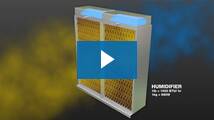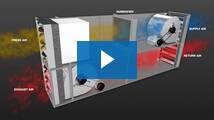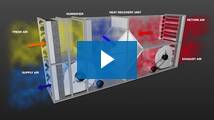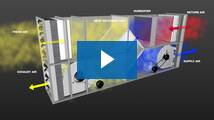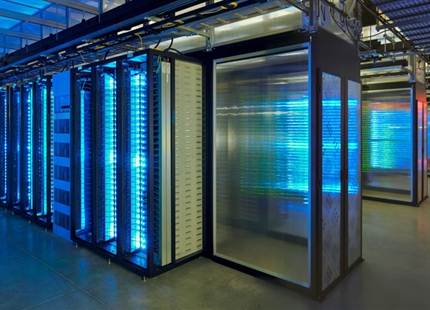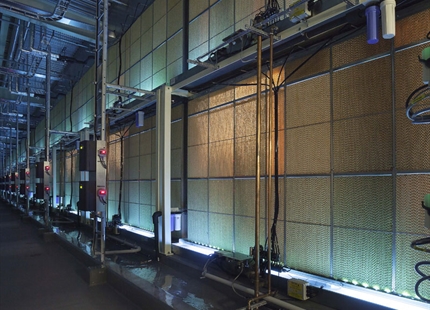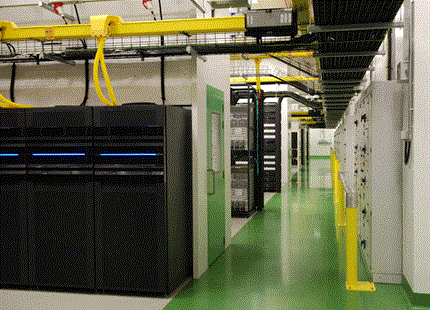
In-duct Evaporative Cooling /
Adiabatic Cooling
The potential of evaporative cooling (adiabatic cooling)
Modern evaporative cooling systems are highly efficient, energy-efficient and dependable, designed to utilize the adiabatic cooling process to regulate indoor conditions with ease. When 2.2 lbs (1kg) of moisture is delivered to the air by an adiabatic humidifier, 680W of evaporative cooling is achieved. As a single adiabatic humidifier can provide up to 2,200 lbs/hr (1,000 kg/h) of moisture from as little as 300W of electricity, their potential for providing low cost adiabatic cooling in air handling units is great.
There are three main strategies for in-duct cooling systems: exhaust air, direct, and indirect evaporative cooling. Take a closer look at each:
2.2 lbs (1kg) of adiabatic humidification provides 680W of evaporative cooling
Direct evaporative cooling
Humidity is added to the incoming fresh air stream, reducing its temperature whilst increasing its humidity. This conditioned air is supplied directly to the room with a high percentage of the room air being exhausted, rather than re-circulated, to maintain a low relative humidity level in the room.
The amount of adiabatic cooling that can be achieved depends upon the relative humidity level of the incoming air stream. Low-humidity air will absorb more moisture, resulting in a greater evaporative cooling effect.
Direct evaporative cooling in an air handling unit, raises the humidity and reduces the temperature
In-direct evaporative cooling
The indirect evaporative cooling strategy uses the outside air to cool an internal environment without any mixing of the internal and external air streams. Fresh outside air is run through the AHU’s heat recovery (HR) unit and then exhausted, while the return air from the room is run through the HR unit before being reintroduced to the room. When the external air stream’s temperature is cooler than the internal air stream, its cool thermal energy is transferred and cools the room.
By humidifying the external air stream prior to entering the HR unit, its temperature is reduced, enhancing the cooling capacity of the system. This allows for an indirect evaporative cooling strategy to be used even when the outside temperature is warmer than the desired supply condition to the room. A higher velocity on the external air stream than the internal further increases the cooling capacity of the system.
In-direct evaporative cooling reduces the temperature without internal and external air streams mixing or moisture being added to the internal air stream
Exhaust air evaporative cooling
The air extracted from the room is first cooled by the humidifier and then run through an HR unit before being vented outside. The cool thermal energy provided by the humidifier is transferred to the incoming air stream by the HR unit, cooling it by a few degrees and reducing the required load on DX air conditioning systems.
As there is no mixing of the humidified exhaust air and the incoming fresh air, there is no moisture added, so cooling occurs irrespective of the incoming air’s relative humidity level.
If you are interested in learning more about direct or indirect evaporative cooling, exhaust-based alternatives or otherwise, the team at Condair is happy to help. With a decades-old history of innovation and engineering expertise, we can provide insights on which solution is best suited for your operational needs. Contact us today to learn more about our state-of-the-art humidification and cooling systems.
Exhaust air cooling reduces the temperature of the incoming fresh air without adding moisture
You may also be interested in...
Why Humidify... For Data Centers
Provides high capacity, low cost evaporative cooling and combats electrostatic discharge that can damage electronics.
Read moreME Series Humidifies Facebook
ME Series humidification systems are maintaining the humidity in Facebook's new data centre in Sweden.
Read moreCondair helps cool Microsoft Dublin
Condair has supplied 35 evaporative humidifiers to Microsoft’s $500 million mega data centre in Dublin, Ireland, to provide up to 8°C of low energy e...
Read more